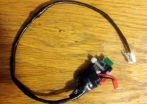(Press-News.org) New York, NY—January 7, 2013—Columbia Engineering's Computer Science PhD candidate Ang Cui and Computer Science Professor Salvatore Stolfo have found serious vulnerabilities in Cisco VoIP (voice over internet protocol) telephones, devices used around the world by a broad range of networked organizations from governments to banks to major corporations, and beyond. In particular, they have discovered troubling security breaches with Cisco's VoIP phone technology. At a recent conference on the security of connected devices, Cui demonstrated how they can easily insert malicious code into a Cisco VoIP phone (any of the 14 Cisco Unified IP Phone models) and start eavesdropping on private conversations—not just on the phone but also in the phone's surroundings—from anywhere in the world.
"It's not just Cisco phones that are at risk. All VoIP phones are particularly problematic since they are everywhere and reveal our private communications," says Stolfo. "It's relatively easy to penetrate any corporate phone system, any government phone system, any home with Cisco VoIP phones—they are not secure."
Cui and Stolfo analyzed the phones' firmware (the software running in the computer inside the phone) and they were able to identify many vulnerabilities. They are particularly concerned with embedded systems that are widely used and networked on the Internet, including VoIP phones, routers, and printers, and have focused their research on developing new advanced security technology to protect these systems.
"Binary firmware analysis is commonly used to identify faulty software by the 'white hat' hackers and security scientists and researchers like our team," Stolfo says. "We performed this analysis to demonstrate a new defense technology, called Software Symbiotes, that protects them from exploitation."
Software Symbiotes is designed to safeguard embedded systems from malicious code injection attacks into these systems, including routers and printers.
"This is a host-based defense mechanism that's a code structure inspired by a natural phenomenon known as symbiotic defensive mutualism," Cui notes. "The Symbiote is especially suitable for retrofitting legacy embedded systems with sophisticated host-based defenses."
The researchers see these Symbiotes as a kind of digital life form that tightly co-exists with arbitrary executables in a mutually defensive arrangement. "They extract computational resources (CPU cycles) from the host while simultaneously protecting the host from attack and exploitation," explains Cui. "And, because they are by their nature so diverse, they can provide self-protection against direct attack by adversaries that directly target host defenses."
"We envision a general-purpose computing architecture consisting of two mutual defensive systems whereby a self-contained, distinct, and unique Symbiote machine is embedded in each instance of a host program," adds Stolfo. "The Symbiote can reside within any arbitrary body of software, regardless of its place within the system stack. It can be injected into an arbitrary host in many different ways, while its code can be 'randomized' by a number of well-known methods."
The Symbiote, which at runtime is required by its host to successfully execute in order for the host to operate, then monitors its host's behavior to ensure it continues to operate correctly, and, if not, it stops the host from doing harm. Removal, or attempted removal, of the Symbiote renders the host inoperable.
"The beauty of the Symbiote," says Cui, "is that it can be used to protect all kinds of embedded systems, from phones and printers to ATM machines and even cars—systems that we all use every day."
Cisco has since released a patch to repair these vulnerabilities but it is ineffective. "It doesn't solve the fundamental problems we've pointed out to Cisco," Cui observes. "We don't know of any solution to solve the systemic problem with Cisco's IP Phone firmware except for the Symbiote technology or rewriting the firmware. We plan to demonstrate a Symbiote-protected Cisco IP Phone at an upcoming conference."
INFORMATION:
The research conducted by Stolfo and Cui was funded by DARPA (Defense Advanced Research Projects Agency), IARPA (Intelligence Advanced Research Projects Activity), and DHS (Department of Homeland Security).
Computer scientists find vulnerabilities in Cisco VoIP phones
2013-01-08
ELSE PRESS RELEASES FROM THIS DATE:
Black and Hispanic patients less likely to complete substance abuse treatment, Penn study shows
2013-01-08
PHILADELPHIA – Roughly half of all black and Hispanic patients who enter publicly funded alcohol treatment programs do not complete treatment, compared to 62 percent of white patients, according to a new study from a team of researchers including the Perelman School of Medicine at the University of Pennsylvania. Comparable disparities were also identified for drug treatment program completion rates. The study, published in the latest issue of Health Affairs, shows that completion disparities among racial groups are likely related to differences in socioeconomic status and, ...
Obese moms risk having babies with low vitamin D
2013-01-08
CHICAGO --- Women who are obese at the start of their pregnancy may be passing on insufficient levels of vitamin D to their babies, according to a new Northwestern Medicine® study.
The study found that babies born to lean mothers had a third higher amount of vitamin D compared to babies born to obese moms.
Vitamin D is fat-soluble, and previous studies have found that people who are obese tend to have lower levels of the vitamin in their blood. In this study, both obese and lean mothers had very similar levels of vitamin D at the end of their pregnancies, yet obese ...
Southern Medical Journal presents special issue on disaster preparedness
2013-01-08
Philadelphia, Pa. (January 7, 2013) – Surveys suggest that while most US physicians are willing to play a role in responding to natural and manmade disasters, most do not feel adequately prepared to fulfill that role. Toward helping physicians and health care systems understand and fulfill their obligation to provide medical care in disasters, the January Southern Medical Journal is a special issue on disaster medicine and physician preparedness. The official journal of the Southern Medical Association, the SMJ is published by Lippincott Williams & Wilkins, a part of Wolters ...
Study looks at how states decide which child receives early intervention for developmental problems
2013-01-08
AURORA, Colo. (Jan. 7, 2013) A new study out by researchers at the University of Colorado School of Medicine, found large differences in the criteria that states use to determine eligibility for Part C early intervention services for infants and toddlers who have developmental delays. A developmental delay is any significant lag in a child's development as compared with typical child development.
Current eligibility criteria for Part C services vary from state to state. With their colleagues, Steven Rosenberg, PhD, associate professor, University of Colorado Department ...
At least 1 in 6 stars has an Earth-sized planet
2013-01-08
The quest for a twin Earth is heating up. Using NASA's Kepler spacecraft, astronomers are beginning to find Earth-sized planets orbiting distant stars. A new analysis of Kepler data shows that about 17 percent of stars have an Earth-sized planet in an orbit closer than Mercury. Since the Milky Way has about 100 billion stars, there are at least 17 billion Earth-sized worlds out there.
Francois Fressin, of the Harvard-Smithsonian Center for Astrophysics (CfA), presented the analysis today in a press conference at a meeting of the American Astronomical Society in Long Beach, ...
Exocomets may be as common as exoplanets
2013-01-08
Comets trailing wispy tails across the night sky are a beautiful byproduct of our solar system's formation, icy leftovers from 4.6 billion years ago when the planets coalesced from rocky rubble.
The discovery by astronomers at the University of California, Berkeley, and Clarion University in Pennsylvania of six likely comets around distant stars suggests that comets – dubbed "exocomets" – are just as common in other stellar systems with planets.
Though only one of the 10 stars now thought to harbor comets is known to harbor planets, the fact that all these stars have ...
People with diabetes in Ontario getting fewer government-funded eye exams, new study finds
2013-01-08
TORONTO, Jan. 7, 2013—A new study has found that adults with diabetes in Ontario are getting significantly fewer government-funded eye exams than they were a decade ago, a key component of high-quality diabetes care essential to preventing diabetes-related eye complications.
The decrease is an unintended consequence of the provincial government's decision in 2004 to delist routine eye exams from the Ontario Health Insurance Plan for healthy adults under age 65, said lead researcher Dr. Tara Kiran.
Routine eye exams continue to be funded for adults with diabetes and other ...
Electronic health records with technical assistance can improve patient care in New York City
2013-01-08
NEW YORK (Jan. 7, 2013) -- The relationship between a physician practice's adoption of electronic health records (EHR) and quality improvements in patient care remains unclear. However, a new study published in the January issue of Health Affairs by Weill Cornell Medical College and the Primary Care Information Project (PCIP) of the New York City Health Department shows evidence that EHR implementation can improve patient care in small physician practices in New York City when combined with sustained high-intensity technical assistance.
To evaluate the effects EHRs have ...
Detecting dusty clouds and stars in our galaxy in a new way
2013-01-08
The center of our Milky Way galaxy is a wondrous place full of huge star clusters, dust clouds, magnetic filaments and a supermassive black hole. But it can be a confusing place, too, posing challenges to astronomers trying to image these exotic features and learn more about where they are located in the galaxy.
Northwestern University's Farhad Zadeh has discovered a new tool for detecting dusty clouds and stars: simply take a picture using radio waves. He is the first to identify what he calls radio dark clouds and stars. Stars in the early and late phases of their ...
Engineered bacteria make fuel from sunlight
2013-01-08
Chemists at the University of California, Davis, have engineered blue-green algae to grow chemical precursors for fuels and plastics -- the first step in replacing fossil fuels as raw materials for the chemical industry.
"Most chemical feedstocks come from petroleum and natural gas, and we need other sources," said Shota Atsumi, assistant professor of chemistry at UC Davis and lead author on the study published Jan. 7 in the Proceedings of the National Academy of Sciences.
The U.S. Department of Energy has set a goal of obtaining a quarter of industrial chemicals from ...


